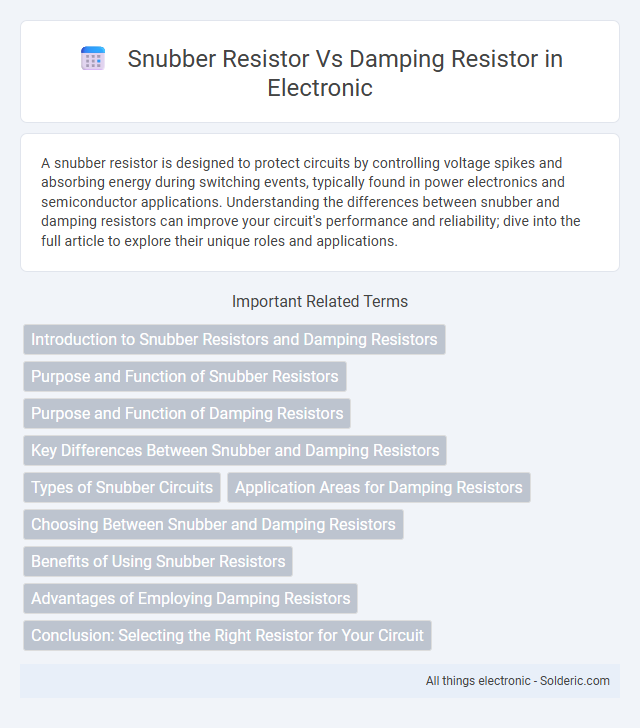A snubber resistor is designed to protect circuits by controlling voltage spikes and absorbing energy during switching events, typically found in power electronics and semiconductor applications. Understanding the differences between snubber and damping resistors can improve your circuit's performance and reliability; dive into the full article to explore their unique roles and applications.
Comparison Table
| Feature | Snubber Resistor | Damping Resistor |
|---|---|---|
| Primary Function | Absorbs voltage spikes, protects switches | Reduces oscillations and ringing in circuits |
| Common Application | RC snubber circuits in power electronics | Series or parallel inductor-capacitor (LC) circuits |
| Energy Dissipation | Converts transient energy into heat | Dissipates stored oscillatory energy |
| Placement | Across switch or transistor terminals | In series with inductors or capacitors |
| Key Benefit | Protects components from voltage spikes | Improves circuit stability and signal integrity |
Introduction to Snubber Resistors and Damping Resistors
Snubber resistors are specifically designed to absorb voltage spikes and limit the rate of voltage change in power electronic circuits, protecting components such as transistors and diodes from transient damage. Damping resistors, on the other hand, are used to reduce oscillations and stabilize circuit response by dissipating energy in resonant circuits or filters. Both resistors play crucial roles in enhancing the reliability and performance of electrical systems by controlling transient behaviors and ensuring stable operation.
Purpose and Function of Snubber Resistors
Snubber resistors primarily protect electronic components by dissipating energy and controlling voltage spikes in circuits with inductive loads, preventing damage from transient surges. They work by absorbing the excess energy generated when current flow is suddenly interrupted, effectively reducing electromagnetic interference (EMI) and voltage overshoot. In contrast, damping resistors mainly reduce oscillations and stabilize circuit behavior without directly managing high-voltage transients.
Purpose and Function of Damping Resistors
Damping resistors are designed to reduce oscillations and mitigate unwanted electrical noise in circuits by dissipating energy and stabilizing voltage fluctuations. Unlike snubber resistors, which primarily protect components by absorbing voltage spikes caused by switching events, damping resistors focus on controlling transient response and preventing resonance within the system. You can enhance circuit stability and prolong component life by selecting appropriate damping resistors tailored to your specific electrical environment.
Key Differences Between Snubber and Damping Resistors
Snubber resistors are primarily used to absorb voltage spikes and protect components in power electronics, while damping resistors reduce oscillations and noise in electrical circuits. Snubber resistors work in tandem with capacitors or diodes to suppress transient voltages, whereas damping resistors are designed to stabilize current and voltage fluctuations. Your choice between snubber and damping resistors depends on whether you need to prevent voltage surges or control signal stability in the circuit.
Types of Snubber Circuits
Snubber resistors are key components in snubber circuits designed to protect switching devices from voltage spikes by dissipating energy, commonly categorized into RC snubbers and RCD snubbers based on their configuration. RC snubber circuits combine a resistor and capacitor in series across the switching device, effectively controlling dv/dt and reducing switching losses. RCD snubber circuits incorporate a resistor, capacitor, and diode to clamp voltage spikes and recycle energy, commonly used in power electronics for transient voltage suppression.
Application Areas for Damping Resistors
Damping resistors are primarily used in power electronic circuits to suppress oscillations and reduce voltage spikes, enhancing the stability of inductive components like transformers and motors. These resistors find application in electromagnetic compatibility (EMC) filters, snubber circuits for switching devices, and resonant circuits to control transient responses. Your electronic designs benefit from damping resistors by improving reliability and minimizing electromagnetic interference (EMI) in high-frequency systems.
Choosing Between Snubber and Damping Resistors
Choosing between a snubber resistor and a damping resistor depends on the application's specific requirements for voltage spike suppression and oscillation control. Snubber resistors are primarily used in RC snubber circuits to absorb voltage transients and protect semiconductor devices from high-voltage spikes. Damping resistors, however, are designed to reduce oscillations and ringing in LC circuits by dissipating energy, ensuring system stability and improving signal integrity for Your electrical designs.
Benefits of Using Snubber Resistors
Snubber resistors protect power electronics by dissipating energy spikes, preventing voltage overshoot and reducing electromagnetic interference, which enhances circuit reliability and longevity. They improve the switching performance of devices like transistors and IGBTs by controlling transient voltages and minimizing stress on components. Using snubber resistors in your design ensures safer operation and reduces the risk of system failures caused by voltage spikes.
Advantages of Employing Damping Resistors
Damping resistors effectively reduce oscillations in electrical circuits, improving system stability and preventing voltage spikes that can damage components. Their ability to dissipate transient energy enhances the longevity of inductive loads and switching devices, such as transformers and relays. Unlike snubber resistors primarily designed for suppressing switching noise, damping resistors provide targeted attenuation of undesired oscillatory behavior, ensuring smoother circuit operation.
Conclusion: Selecting the Right Resistor for Your Circuit
Choosing the right resistor for your circuit depends on the specific application: snubber resistors are ideal for suppressing voltage spikes in switching devices, while damping resistors effectively control oscillations in resonant circuits. Your decision should consider factors like power dissipation, resistance value, and circuit stability requirements to ensure optimal performance. Evaluating these parameters will help you select the resistor type that enhances reliability and protects components in your electronic system.
Snubber resistor vs damping resistor Infographic

 solderic.com
solderic.com